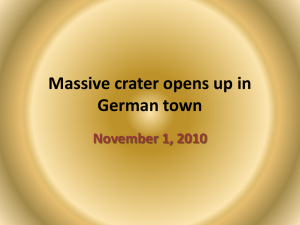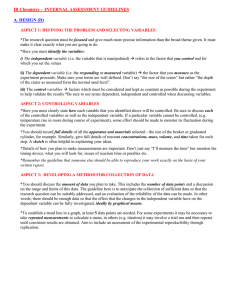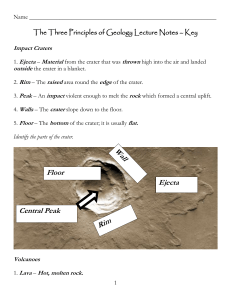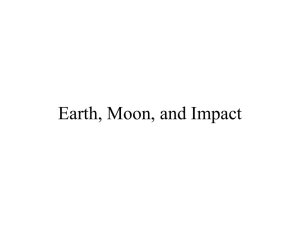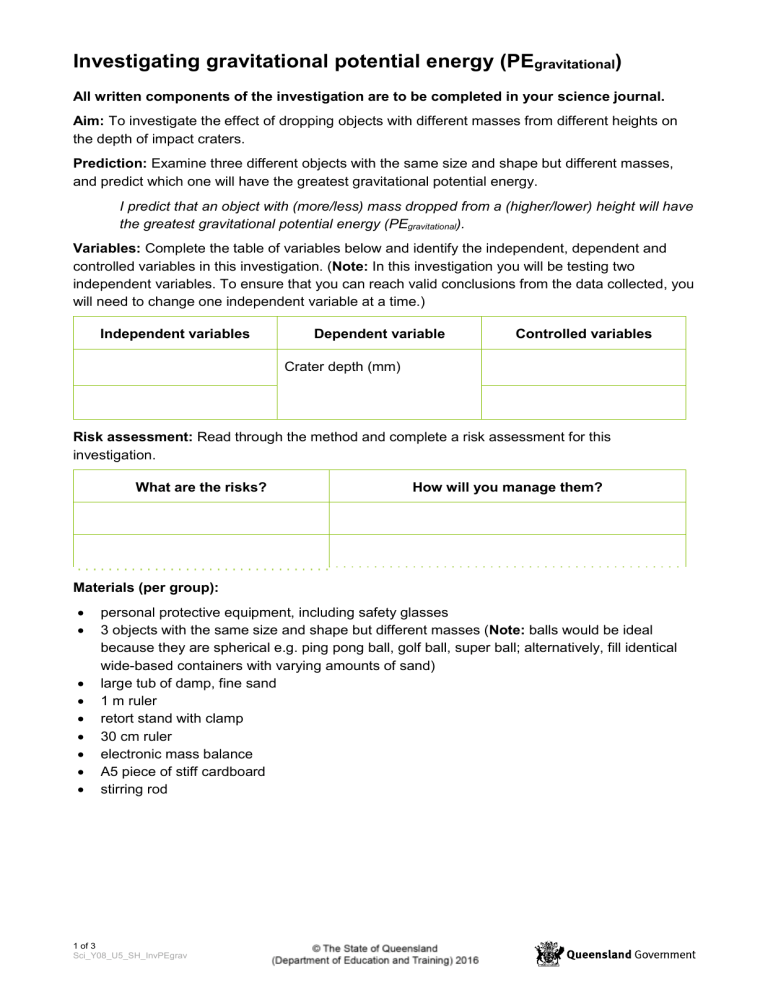
Investigating gravitational potential energy (PEgravitational) All written components of the investigation are to be completed in your science journal. Aim: To investigate the effect of dropping objects with different masses from different heights on the depth of impact craters. Prediction: Examine three different objects with the same size and shape but different masses, and predict which one will have the greatest gravitational potential energy. I predict that an object with (more/less) mass dropped from a (higher/lower) height will have the greatest gravitational potential energy (PEgravitational). Variables: Complete the table of variables below and identify the independent, dependent and controlled variables in this investigation. (Note: In this investigation you will be testing two independent variables. To ensure that you can reach valid conclusions from the data collected, you will need to change one independent variable at a time.) Independent variables Dependent variable Controlled variables Crater depth (mm) Risk assessment: Read through the method and complete a risk assessment for this investigation. What are the risks? How will you manage them? Materials (per group): personal protective equipment, including safety glasses 3 objects with the same size and shape but different masses (Note: balls would be ideal because they are spherical e.g. ping pong ball, golf ball, super ball; alternatively, fill identical wide-based containers with varying amounts of sand) large tub of damp, fine sand 1 m ruler retort stand with clamp 30 cm ruler electronic mass balance A5 piece of stiff cardboard stirring rod 1 of 3 Sci_Y08_U5_SH_InvPEgrav Method: 1. Make sure you are wearing personal protective equipment, including safety glasses and appropriate footwear. 2. Measure the mass of each ball and record this in a results table. 3. Sit the tub of damp sand on the floor. 4. Use the 30 cm ruler to smooth the surface so that it is even. 5. Place the retort stand beside the tub and clamp the 1 m ruler to use as a guide for measuring the drop height. The 0 cm mark on the ruler should be at the surface level of the sand. 6. Write a suitable method to accurately measure the depth of the impact crater in mm, using the cardboard, stirring rod and ruler. ___________________________________________________________________ 7. Drop the first object from a 30 cm height into the sand and then carefully remove the object without disturbing the sand. 8. Carefully measure the depth of the crater using your method. 9. Record the depth of the impact crater in the results table. 10. Smooth the surface of the tub before the next trial. 11. Repeat steps 7–10 twice more. 12. Repeat steps 7–11 for 60 cm and then 100 cm drop heights. 13. Repeat steps 7–12 for the other two objects of different mass. Results: Draw a results table to record your measurements, remembering that you are testing two independent variables: mass and height. The following is an example of how data for Object 1 might be recorded in a table. Ensure that you choose a format that will enable you to show all the data collected in this experiment. Object Mass (g) 1 2 of 3 Sci_Y08_U5_SH_InvPEgrav Crater depth 30 cm drop Crater depth 60 cm drop Crater depth 100 cm drop 1. 1. 1. 2. 2. 2. 3. 3. 3. Av. Av. Av. Represent your data in a bar graph showing the relationship between each independent variable and the dependent variable. (Use an appropriate scale for the crater depth.) Average crater depth (mm) The effect of mass or height of drop on crater depth (PEgravitational) 0 30 60 100 Object 1 (?) g 30 60 100 Object 2 (?) g 30 60 100 Object 3 (?) g Mass of object (g) / Height of drop (cm) Discussion: 1. Compare your data with your prediction. Explain any differences. 2. What relationship do you think exists between crater depth and the amount of gravitational potential energy? 3. What conclusions can you make about gravitational potential energy, mass and drop height? Justify your conclusions using your data. 4. How did you ensure your tests were fair? 5. What improvements could you make to the method? 6. How and why would these improvements increase the accuracy and reliability of the data collected? (Hint: Consider controlling variables.) Conclusion: Write statements summarising your conclusions as they relate to your data and the aim of the investigation. 3 of 3 Sci_Y08_U5_SH_InvPEgrav

